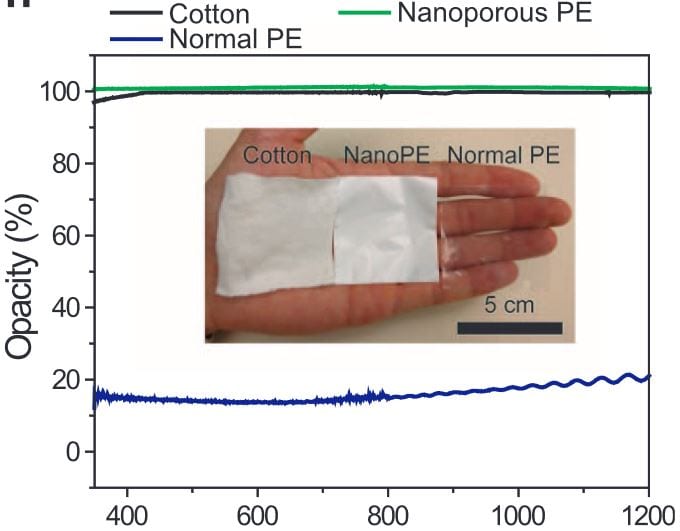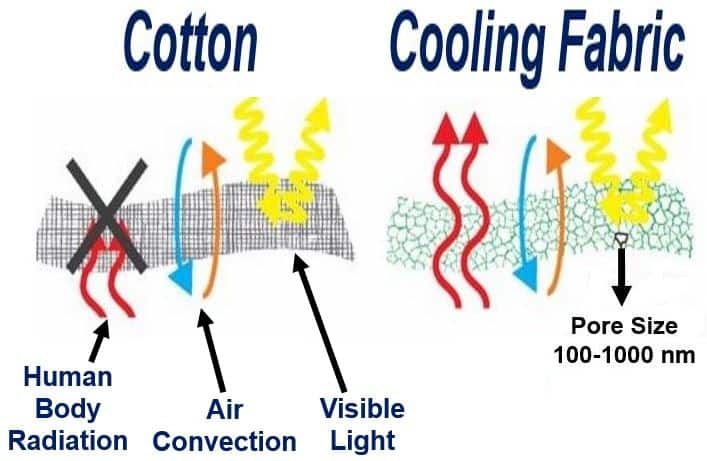There is a new cooling fabric that prevents the human body from overheating in hot weather, so that people do not need to turn on the air conditioning so soon. Fabric, in this context, means cloth or textile.
This new, cheap plastic material should help reduce our demand for energy-hungry cooling systems in our homes and offices, says a team of scientists from Stanford University.
The researchers explained in the journal Science how they developed a plastic-based textile which can be woven into a cooling fabric, i.e. textiles for making items of clothing.
Co-author, Professor Yi Cui, who works at Stanford’s SLAC National Accelerator Laboratory, and colleagues say that the cooling fabric would prevent people from feeling too hot, something that current clothing materials cannot do.
 The Stanford engineers began with a polyethylene sheet, which they modified with a series of chemical treatments, and eventually created a cooling fabric. (Image: stanford edu. Credit: L A Cicero)
The Stanford engineers began with a polyethylene sheet, which they modified with a series of chemical treatments, and eventually created a cooling fabric. (Image: stanford edu. Credit: L A Cicero)
This new material makes you feel 2.7°C (3.6°F) cooler than any clothing available today can.
Prof. Cui says we are close to creating a new family of cooling fabrics that will eventually become the basis for garments that keep us cool in hot climates with less need for energy-hungry climate control systems. Instead of having to cool the room, house or building, your body is cooled instead.
Cool the person – not the building
Prof. Cui explained:
“If you can cool the person rather than the building where they work or live, that will save energy.”
With this revolutionary new material, the human body can release heat in two ways:
1. Perspiration evaporates through the material – something that already occurs with most current garments.
2. Infrared radiation from our bodies passes right through it – this does not occur with current garment materials.
 Visible opacity measurement quantitatively confirms that nanoporousPE (the new material – the cooling fabric) is as opaque as cotton. (Image: science.sciencemag.org)
Visible opacity measurement quantitatively confirms that nanoporousPE (the new material – the cooling fabric) is as opaque as cotton. (Image: science.sciencemag.org)
Our bodies throw off heat in the form of infrared radiation, also known as thermal radiation, which consist of invisible radiant energy with longer wavelengths than those of light we can see.
When you cover yourself with a blanket, the infrared heat emissions close to your body are trapped.
Co-author, Shanhui Fan, from the Stanford Photonics Research Centre, said:
“Forty to 60 percent of our body heat is dissipated as infrared radiation when we are sitting in an office. But until now there has been little or no research on designing the thermal radiation characteristics of textiles.”
Mega-powerful kitchen wrap
In order to develop this new cooling fabric, the engineers blended chemistry, nanotechnology and photonics to give polyethylene a number of features desirable in clothing material:
1. Air can pass through it. Which means water vapour goes through.
2. Thermal radiation is not trapped – it also passes through it.
3. It is opaque to visible light. This means it is not see-through. Polyethylene (kitchen wrap, UK: cling film) is completely see through. We could not wear polyethylene clothing because we would still look naked.
 The cooling fabric allows infrared heat to pass through – the cotton doesn’t. (Image: science.sciencemag.org)
The cooling fabric allows infrared heat to pass through – the cotton doesn’t. (Image: science.sciencemag.org)
Allowing infrared radiation to pass through it was easy, because that feature already exists in normal kitchen food wrap.
Allowing water to pass through and making it opaque were less straightforward – kitchen wrap is waterproof and see through.
The scientists first found a variant of polyethylene that is widely used in battery making that has a specific opaque nanostructure to visible light but not to infrared radiation – it is not see through but heat can pass through it.
The industrial polyethylene was treated with benign chemicals so that water vapour molecules could evaporate through microscopic holes – nanopores – in the plastic. Co-author Po-Chun Hsu, a postdoctoral scholar, said this allowed the material to breathe like natural fibre.
Making a cooling fabric for clothing
The team now had a single-sheet material that met the three basic criteria for a cooling textile:
1. It was opaque – non-transparent.
2. Heat went through it.
3. Water vapour went through it.
To make this ultra thin material more like the fabrics in our clothes, they created a three-ply version: two sheets of treated polyethylene with a cotton mesh in between for strength and thickness.
Now they had to test their new material against a cotton fabric of comparable thickness to see which had the best cooling potential. They placed two swathes of equal size of each material on a surface that was set at the same temperature as our skin, and measured how much heat was trapped.
Prof. Fan explained:
“Wearing anything traps some heat and makes the skin warmer. If dissipating thermal radiation were our only concern, then it would be best to wear nothing.”
Cooling fabric kept skin surface cooler
There was a clear difference in the cooling potential between the cotton fabric and the new material (cooling fabric). The cooling fabric kept the skin surface 3.6°F or 2.7°C cooler than the cotton fabric.
The authors explained that this meant that humans wearing clothes made with this cooling fabric would tolerate higher temperatures before turning on the air conditioning or using a ventilator (fan).
They now plan to add more colours and textures to their new fabric, as well as finding ways of making it look more like clothing cloth.
Producing this new material in large quantities would be easy, given that the basic material is already mass produced for the battery industry.
Prof. Cui said:
“If you want to make a textile, you have to be able to make huge volumes inexpensively.”
The authors believe their research has opened up new avenues of inquiry into producing goods that control temperature passively – without needing to use outside energy. Perhaps one day new materials could be tuned to dissipate or trap infrared radiation.
Prof. Fan said:
“In hindsight, some of what we’ve done looks very simple, but it’s because few have really been looking at engineering the radiation characteristics of textiles.”
The authors made the following comment in an Abstract that preceded the main paper in the journal:
“We developed a device to simulate skin temperature that shows temperatures 2.7° and 2.0°C lower when covered with nanoPE cloth and with processed nanoPE cloth, respectively, than when covered with cotton. Our processed nanoPE is an effective and scalable textile for personal thermal management.”
Reference: “Radiative human body cooling by nanoporous polyethylene textile,” Alex Y. Song, Po-Chun Hsu, Peter B. Catrysse, Shanhui Fan, Chong Liu, Yucan Peng, Jin Xie & Yi Cui. Science. 2nd September 2016. Vol. 353, Issue 6303, pp. 1019-1023. DOI: 10.1126/science.aaf5471.
Video – Cooling fabric created by scientists
Stanford scientists have created a plastic textile that cools the body in two ways. Its carefully-engineered nanostructure allows perspiration to evaporate, as it does with ordinary clothing, while also allowing body heat to escape as infrared light.
